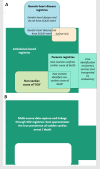Cardiac arrest and sudden cardiac death registries: a systematic review of global coverage
- PMID: 32076566
- PMCID: PMC6999684
- DOI: 10.1136/openhrt-2019-001195
Cardiac arrest and sudden cardiac death registries: a systematic review of global coverage
Abstract
Background: Sudden cardiac death (SCD) is a major global health problem, accounting for up to 20% of deaths in Western societies. Clinical quality registries have been shown in a range of disease conditions to improve clinical management, reduce variation in care and improve outcomes.
Aim: To identify existing cardiac arrest (CA) and SCD registries, characterising global coverage and methods of data capture and validation.
Methods: Biomedical and public search engines were searched with the terms 'registry cardio*'; 'sudden cardiac death registry' and 'cardiac arrest registry'. Registries were categorised as either CA, SCD registries or 'other' according to prespecified criteria. SCD registry coordinators were contacted for contemporaneous data regarding registry details.
Results: Our search strategy identified 49 CA registries, 15 SCD registries and 9 other registries (ie, epistries). Population coverage of contemporary CA and SCD registries is highly variable with registries densely concentrated in North America and Western Europe. Existing SCD registries (n=15) cover a variety of age ranges and subpopulations, with some enrolling surviving patients (n=8) and family members (n=5). Genetic data are collected by nine registries, with the majority of these (n=7) offering indefinite storage in a biorepository.
Conclusions: Many CA registries exist globally, although with inequitable population coverage. Comprehensive multisource surveillance SCD registries are fewer in number and more challenging to design and maintain. Challenges identified include maximising case identification and case verification.
Trial registration number: CRD42019118910.
Keywords: emergency medicine; epidemiology; resuscitation; sudden cardiac death.
© Author(s) (or their employer(s)) 2020. Re-use permitted under CC BY-NC. No commercial re-use. See rights and permissions. Published by BMJ.
Conflict of interest statement
Competing interests: None declared.
Figures



Comment in
-
The autopsy is still valuable: National registries and promoting autopsy after sudden cardiac death.Heart Rhythm. 2024 May;21(5):684-685. doi: 10.1016/j.hrthm.2024.01.037. Epub 2024 Jan 26. Heart Rhythm. 2024. PMID: 38280623 No abstract available.
References
-
- Gliklich RDN, Center OD. Registries for Evaluating Patient Outcomes: A User’s Guide. Rockville, Maryland, 2010.
-
- ACSQHC Economic evaluation of clinical quality registries: final report. Sydney, 2016.
Publication types
MeSH terms
LinkOut - more resources
Full Text Sources
Medical
